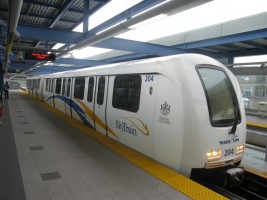
CAF 5013
Location: Prince George’s Plaza Station, Hyattsville, MD
Operator of Vehicle: Washington Metropolitan Area Transit Authority
Date of Photo: July 2, 2007
The DC Metrorail will be celebrating its 43rd anniversary later this month, but one of its newer classes of rolling stock is no longer around to commemorate the occasion. WMATA exercised an option order on its new 7000 Series cars from Kawasaki in order to retire the CAF built 5000 Series trains as opposed to rehabbing them. Typically, a Metrorail car can have a service life of nearly 40 years if it is rehabilitated or overhauled after about 20 years of service. However, the CAFs have been lemons in a variety of ways since they arrived on Metro property. First, their delivery was delayed due to a variety of software and other manufacturing issues. Once they arrived, the CAF cars derailed more often than the other car classes (fortunately, within train yards except on one occasion), they also broke down more often than the other car classes. However, the CAFs left positive impressions on WMATA’s history. They were the first cars to feature the updated interior colors of Potomac Blue, Colonial Burgundy, and Chesapeake Sand, the first cars to have LED exterior destination signage, the first cars to have interior LED next stop displays, the first cars to be delivered with AC traction motors, and the first cars to have a module on the operator’s console to help troubleshoot problems on board the train.
The 5000 Series cars are also notable for being the first heavy rail contract CAF received from a North American agency. The company has won additional contracts in the US since then, including for the construction of MBTA’s Type 9 cars and Amtrak’s Viewliner IIs. CAF has also been contracted to build the light rail cars that will be used on the Purple Line in the Maryland suburbs. I’ve heard other transit fans complain about the quality of CAF products, and they also cite delivery delays on these and other contracts. However, I’ve been on CAF built trains in Spain and Italy in addition to DC. In my experience, the CAF trains I have been on in Europe seem to be well constructed and reliable.
WMATA’s 5000 Series cars were removed from revenue service in October 2018, although some are being used as part of work trains as of this writing. And while they may not be a part of Metro’s story going forward and didn’t even remain in service for 20 years, the CAF cars will always be a part of Metro’s history in the early 21st century.
For more photos of WMATA’s 5000 Series cars, please click here.

